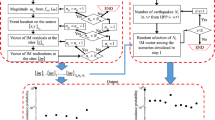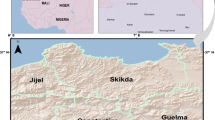Abstract
The seismic hazard map or delineation of regions with high earthquake hazard is important to plan risk mitigation strategies. Identifying areas of high seismic hazard can lead city planners to enforce better construction standards and predict areas vulnerable to slope instability. Conventional seismic hazard maps are based on limited factors like ground acceleration, ground velocity, etc. This paper presents a new class of data-driven multivariate rule–based model to create online as well as offline interactive seismic hazard map that is flexible and readily automated. A multivariate rule-based seismicity map (MRBSM) is defined as the map of regions with a future high hazard of earthquakes. The classification and regression tree method is used to extract rules that predict regions with high hazard of earthquakes with mb ≥ 4.5 in Iran. The rules generated for our MRBSM of Iran are based on a large number of geological and geophysical parameters. The MRBSM indicates that the province of Bandar Abbas, a major population center in the South of Iran has a high hazard of earthquakes with mb ≥ 4.5. In addition, our method allows identification of the most important parameters associated with earthquakes. Our analysis shows that the isostatic anomaly has the strongest correlation with earthquakes while magnetic intensity, regional Bouger anomaly, Bouger anomaly, and gravity anomaly also correlate well. Despite widespread application of a- and b-values of the Gutenberg-Richter formula, these parameters do not correlate well with earthquake hazards in the area.
Similar content being viewed by others
References
Alavi M (1991) 1/5,000,000 sheet, tectonic map of middle east. Geol Suev Iran
Ambraseys NN, Monifar A (1973) The seismicity of Iran. The Silkhor, Lurestan, Erthquake of 23rd January 1909. Ann Geophys 4: 659–678
Ambraseys NN, Melville CP (1982) A history of persian earthquakes. Cambridge Univ Press, Cambridge, p 219
Ambraseys NN (2001) Reassessment of earthquakes, 1900–1999, in the Eastern Mediterranean and the Middle East. Geophys J Int 45(2): 471–485
Ashtari Jafari M (2010) Statistical prediction of the next great earthquake around Tehran, Iran. Geodyn 49: 14–18
Berberian M (1973) 1/2500000 sheet, the seismicity of Iran. Preliminary map of epicenters and focal depth. Geol Suev Iran
Berberian M (1976) Contribution to the seismotectonics of Iran (part II). Geol Suev Iran, Report no 39, Tehran, pp 518
Berberian M (1977) Contribution to the seismotectonics of Iran (part III). Geol Suev Iran, Report no 40, Tehran, pp 300
Berberian M (1979) Discussion of the paper A. A. Nowroozi, 1976 seismotectonic province of Iran. Bull Seismol Soc Am 69:293–297
Berberian M (1995) Natural hazards and the first earthquake catalogue of Iran. IISEE, Iran, p 603
Berg JW, Gaskell R, Rinehart V (1964) Earthquake energy release and isostasy. Bull Seismol Soc Am 54(2): 777–784
Bonini M, Corit G, Sokoutis D, Vannucci G, Gasperini P, Cloetingh S (2003) Insight from scaled analogue modeling into the seismotectonics of the Iranian region. Tectonophys 376: 149–157
Bouchon M (1973) Effect of topography on surface motion. Bull Seismol Soc Am 63: 615–632
Breiman L, Friedman JH, Olshen RA, Stone CJ (1984) Classification and regression trees. Wadsworth, Inc, Monterey
Caputo M, Milana G, Rayhorn J (1984) Topography and its isostatic compensation as a cause of seismicity of the Apennines. Tectonophys 102: 333–342
Caputo M, Manzetti V, Nicelli R (1985) Topography and its isostatic compensation as a cause of seismicity; a revision. Tectonophys 111: 25–39
Chen YT, Liu KR, Zheng JH, Song SH, Liu RF, Lu HY, Gu FY (2002) A review of the studies on the relationship between local gravity field changes and earthquakes. In: Sun S (ed) Advances in pure and applied geophysics. Meteorology Press, Beijing, pp 40–47 (in Chinese)
Daubie M, Levecq P, Meskens N (2002) A comparison of rough sets and recursive partitioning induction approaches: an application to commercial loans. Int Trans Oper Res 9: 681–694
Davis LL, West LR (1973) Observed effects of topography on ground motion. Bull Seismol Soc Am 63: 283–298
Dehghani GA, Makris J (1983) The gravity field and crustal structure of Iran. In: Geodynamic Project (Geotraverse) in Iran. Geol Suev Iran, pp 51–68
Dmeroski S (2002) Applications of KDD methods in environmental sciences. In: Kloesgen W, Zytkow J (eds) Handbook of data mining and knowledge discovery. Oxford Univ Press, Oxford
Engdahl ER, Vander Hilst RD, Buland RP (1998) Global teleseismic earthquake relocation with improved travel times and procedures for depth determination. Bull Seismol Soc Am 88: 722–743
Engdahl ER, Jackson JA, Myers SC, Bergman E A, Priestley K (2006) Relocation and assessment of seismicity in the Iran region. Geophys J Int 167: 761–778
Fowler CMR (2005) The solid earth: an introduction to global geophysics. Cambridge Univ Press, Cambridge
Fu LM (1999) Knowledge discovery based on neural networks. Commun ACM 42(11): 47–50
Geli L, Bard PY, Jullien BA (1988) The effect of topography ground motion: a review and new results. Bull Seismol Soc Am 78(1): 42–63
Geological Survey of Iran (2004) 1/5,000,000 sheet, geological map of Iran. Ministry of Industries and Mines
Gutenberg B, Richter CF (1954) Seismicity of the earth and its associate phenomena. Princeton University Press, Princeton, p 310
Hough SE, Bhat I, Bilham R (2009) On shaky ground- megaquakes in Kashmir. Am Sci 97(1): 42–49
Iftikhar US, Toshinori M (2009) Application of rough set and decision tree for characterization of premonitory factors of low seismic activity. Exp Syst Appl 36: 102–110
ISC: (2012) International seismological centre. Newbury, Berkshire
Johnston MJS (1997) Review of electric and magnetic fields accompanying seismic and volcanic activity. Surv Geophys 18: 441–475
Karakaisis GF (1994) Long-term earthquake prediction in Iran based on the time and magnitude predictable model. Phys Earth Planet Inter 83: 129–145
Lewis RJ (2000) An introduction to classification and regression tree (CART) analysis. Department of Emergency Medicine, Harbor-UCLA Medical Center, Torrance
Li ZX, Li H (2009) Earthquake-Related gravity field changes at Beijing-Tangshan gravimetric network during 1987–1998. Stud Geophys Geod 53: 185–197
Lomnitz C (1994) Fundamental of earthquake prediction. Wiley, New York, p 326
Mitchell T (1997) Machine learning. McGraw-Hill, New York, p 400
Mohajer-Ashjai A, Nabavi MS (1982) 1/2,500,000 sheet, seismicity and fault map of Iran. AEOI
NEIC: (2012) National earthquake information center. Colorado, USA
Niazi M, Basford JR (1968) Seismicity of Iranian Plateau and Hindu Kush region. Bull Seismol Soc Am 58: 1843–1861
Nowroozi A (1971) Seismotectonics of the Persian Plateau, eastern Turkey, Caucasus, and Hindu-Kush regions. Bull Seismol Soc Am 61: 317–341
Nowroozi A (1976) Seismotectonic provinces of Iran. Bull Seismol Soc Am 66: 1249–1276
Nowroozi A (1979) Reply to M, Berberian comparison between instrumental and macroseismic epicenter. Bull Seismol Soc Am 69: 641–649
Oates T, Jensen D (1997) The effects of training set size on tree size. In: 14th international conference on machine learning, pp 254–262
Pawlak Z, Slowinski R (1994) Decision analysis using rough sets. Int Trans Oper Res 1: 104–107
Petersen JF, Sack D, Gable RE (2011) Physical geography. Thomson Brooks/Cole, Belmont, p 646
Pulinets SA (2006) Space technologies for short-term earthquake warning. Adv Space Res 37: 643–652
Quinlan JR (1993) C4.5: Programs for machine learning. Morgan Kaufman, San Mateo
Ripley BD (1996) Pattern Recognition and neural networks. Cambridge Univ Press, Cambridge, p 403
Rogers GC, Cassidy JF, Weichert DH (1998) Variation in earthquake ground motion on the Fraser Delta from strong motion seismograph records. In: Clagve JJ, Luternauer JC, Mosher DC (eds) Recent geological, geophysical, geotechnical, and geochemical research. Fraser River Delta, British, Columbia. Geologic Surv Canada Bull 525:195–210
Shoja-Taheri J, Niazi M (1981) Seismicity of Iranian Plateau and bordering regions. Bull Seismol Soc Am 71: 477–489
Standart G, Penaloza M, Zong Z (2010) Use of data mining techniques in the discovery of spatial and temporal earthquake relationship. Proceedings of midwest instruments computation symposium
Steinberg D, Colla P (1997) Classification and regression trees. Salford Systems, San Diego
Stöcklin J (1968) Structural history and tectonics of Iran: a review. Am Assoc Petrol Geol Bull 52: 1229–1258
Tavakoli B (1996) Major seismetectonic provinces of Iran. unpublished map. IIEES, inter doc (in Persian)
Tavakoli B, Ghafory-Ashtiany M (1999) Seismic hazard assessment of Iran. Annali DI Geofisica 42: 1013–1021
Tchalenko JS (1975) Seismicity and structure of the North Tehran fault. Tectonophys 29: 411–420
Turcotte D, Schubert G (2002) Geodynamics-applications of continuum physics to geological problems. Cambridge University Press, Cambridge, p 450
Wilson AT (1930) Earthquakes in Persia. Bull Sch Orient Stud Lond 6: 103–131
Yousefi E (1989) 1/250,000 sheets, total magnetic intensity maps of Iran. Geol Suev Iran
Zamani A, Hashemi N (2000) A comparison between seismicity, topographic relief, and gravity anomalies of Iranian Plateau. Tectonophys 327: 25–36
Zamani A, Hashemi N (2004) Computer-based self-organized tectonic zoning: a tentative pattern recognition for Iran. Comput Geosci 30: 705–718
Zamani A, Agh-Atabai M (2009) Temporal characteristics of seismicity in the Alborz and Zagros region of Iran, using a multifractal approach. J Geodyn 47: 271–279
Zamani A, Agh-Atabai M (2011) Multifractal analysis of the spatial distribution of earthquake epicenters in Zagros and Alborz-Kopeh Dagh region of Iran. IJST A1: 39–51
Zamani A, Farahi Ghasre-Aboonasr S (2011) The significance of parameters used for selforganized tectonic zoning of Iran. Iran Geosci J 81:165–170 (in Persian)
Zamani A, Khalili M, Gerami A (2011) Computer-based self-organized zoning revisited: scientific criterion for determining the optimum number of zones. Tectonophys 510: 207–216
Zmazek B, Todorovski L, Dzeroski S, Vaupotic J, Kobal I (2003) Application of decision trees to the analysis of soil radon data for earthquake prediction. Appl Radi Isot 58: 697–706
Author information
Authors and Affiliations
Corresponding author
Rights and permissions
About this article
Cite this article
Zamani, A., Sami, A. & Khalili, M. Multivariate rule-based seismicity map of Iran: a data-driven model. Bull Earthquake Eng 10, 1667–1683 (2012). https://doi.org/10.1007/s10518-012-9386-3
Received:
Accepted:
Published:
Issue Date:
DOI: https://doi.org/10.1007/s10518-012-9386-3




